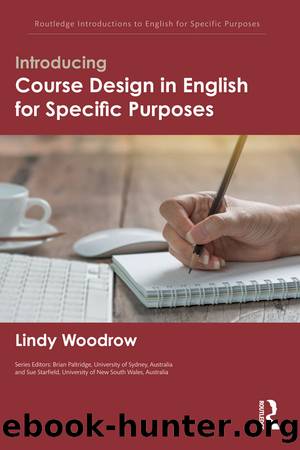Introducing Course Design in English for Specific Purposes (Routledge Introductions to English for Specific Purposes) by Lindy Woodrow

Author:Lindy Woodrow [Woodrow, Lindy]
Language: eng
Format: epub
Publisher: amazon
Published: 0101-01-01T00:00:00+00:00
Types of corpus
As technology becomes more sophisticated and user friendly, there is an increasing number of corpora available. Corpora can be general or specific. For example, the British National Corpus (BNC) is a general purpose, 100-million-word corpus drawn from spoken and written texts from a range of sources. Another general corpus is the Corpus of Contemporary American English (COCA). This is a 520-million-word corpus drawn from spoken and written American English texts including academic journals.
Subject-specific corpora range from large-scale to small-scale corpora. An example of a large-scale, specific corpus is the Cambridge and Nottingham Business English Corpus (CANBEC). This collection of texts featuring spoken and written British and American English from business situations is used to inform Business English textbooks published by Cambridge. In the field of EAP, the Professional English Research Consortium has produced the Corpus of Professional English (CPE), which is a 140-million-word corpus drawn from research articles.
Not all corpora are accessible. The CANBEC and the Cambridge and Nottingham Corpus of Discourse in English (CANCODE) are only accessible by those associated with Cambridge University Press; and the TOEFL 2000 spoken and written academic-language corpus (TKSWAL) is not freely available to the public. However, there are many resources that are freely available. While the corpus used to generate the Academic Word List (AWL) (Coxhead, 2000) is restricted, the results of the analysis are freely available. The AWL takes the form of word lists ordered in terms of frequency, a very useful resource for EAP practitioners and students, and the list has been widely exploited for pedagogic purposes – see, for example, the University of Nottingham’s material on using the AWL (Haywood, online). The many other corpora that are freely available are listed in Chapter 15 on resources for ESP course design.
Corpora can also be specifically designed and built for ESP courses or for research. In these cases the corpus will be small but may be much more useful than the large, institutionally sponsored corpora. Bowker and Pearson (2002) provide guidance on how to design and build such a corpus. An example of a specialist corpus is Staples’ (2015) nursing corpus. She collected 102 interactions between nurses and standardised patients (that is, actors playing patients and providing the same response across a number of interactions). From this corpus she analysed the interactions for genre moves and then conducted a lexico-grammatical analysis. This was translated into course objectives and a syllabus (see Chapter 10 for more discussion of her approach).
An example of a business-English corpus is Mike Nelson’s, based on his PhD thesis. He analysed this using the Wordsmith concordancing software to identify keywords and frequency lists of spoken and written business English. He compared his corpus with the BNC and noted some important differences in usage (Nelson, 2000). The corpus is not yet available online; however, Nelson’s Business English Lexis Site is a valuable resource for EBP practitioners and includes frequency lists and key phrases in business English (Nelson, online).
A current focus in workplace ESP is business English as a lingua franca (BELF).
Download
This site does not store any files on its server. We only index and link to content provided by other sites. Please contact the content providers to delete copyright contents if any and email us, we'll remove relevant links or contents immediately.
Cecilia; Or, Memoirs of an Heiress — Volume 1 by Fanny Burney(31324)
Cecilia; Or, Memoirs of an Heiress — Volume 3 by Fanny Burney(30928)
Cecilia; Or, Memoirs of an Heiress — Volume 2 by Fanny Burney(30885)
The Lost Art of Listening by Michael P. Nichols(6464)
We Need to Talk by Celeste Headlee(4862)
Asking the Right Questions: A Guide to Critical Thinking by M. Neil Browne & Stuart M. Keeley(4566)
On Writing A Memoir of the Craft by Stephen King(4205)
Dialogue by Robert McKee(3576)
I Have Something to Say: Mastering the Art of Public Speaking in an Age of Disconnection by John Bowe(3513)
Pre-Suasion: A Revolutionary Way to Influence and Persuade by Robert Cialdini(3404)
Elements of Style 2017 by Richard De A'Morelli(2940)
The Book of Human Emotions by Tiffany Watt Smith(2767)
Good Humor, Bad Taste: A Sociology of the Joke by Kuipers Giselinde(2554)
Name Book, The: Over 10,000 Names--Their Meanings, Origins, and Spiritual Significance by Astoria Dorothy(2488)
Fluent Forever: How to Learn Any Language Fast and Never Forget It by Gabriel Wyner(2442)
The Grammaring Guide to English Grammar with Exercises by Péter Simon(2391)
Why I Write by George Orwell(2355)
The Art Of Deception by Kevin Mitnick(2295)
Don't Sleep, There Are Snakes by Daniel L. Everett(2213)
